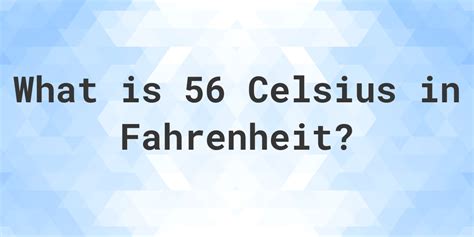What Is 56 C In Fahrenheit
Kalali
Mar 31, 2025 · 4 min read

Table of Contents
What is 56°C in Fahrenheit? A Comprehensive Guide to Temperature Conversions
Converting temperatures between Celsius (°C) and Fahrenheit (°F) is a common task, whether you're checking a weather forecast, following a recipe, or working with scientific data. Understanding the conversion process is crucial for accurate interpretation and effective communication across different systems. This article delves deep into the conversion of 56°C to Fahrenheit, providing not just the answer but also a thorough explanation of the method, its applications, and related concepts.
Understanding the Celsius and Fahrenheit Scales
Before we dive into the conversion, let's briefly review the two temperature scales involved:
-
Celsius (°C): Also known as the centigrade scale, Celsius is a metric unit based on the freezing and boiling points of water. Water freezes at 0°C and boils at 100°C at standard atmospheric pressure. This scale is widely used globally, especially in scientific contexts.
-
Fahrenheit (°F): This scale is primarily used in the United States and a few other countries. Water freezes at 32°F and boils at 212°F at standard atmospheric pressure. The Fahrenheit scale has a smaller degree interval than Celsius, meaning a degree Fahrenheit represents a smaller temperature change.
The Conversion Formula: From Celsius to Fahrenheit
The formula for converting Celsius to Fahrenheit is:
°F = (°C × 9/5) + 32
This formula takes the Celsius temperature (°C), multiplies it by 9/5 (or 1.8), and then adds 32. This adjustment accounts for the difference in the zero points and the degree intervals of the two scales.
Converting 56°C to Fahrenheit
Let's apply the formula to convert 56°C to Fahrenheit:
°F = (56°C × 9/5) + 32
°F = (100.8) + 32
°F = 132.8
Therefore, 56°C is equal to 132.8°F.
Real-World Applications of Temperature Conversions
Understanding temperature conversions is essential in various fields:
1. Meteorology and Climate Science:
Weather reports often provide temperatures in both Celsius and Fahrenheit. Converting between these scales is vital for interpreting weather data from different sources and understanding global climate patterns. A temperature of 56°C, for instance, indicates extremely hot conditions – a heatwave – requiring appropriate precautions and safety measures.
2. Cooking and Baking:
Many recipes specify temperatures in either Celsius or Fahrenheit. Accurate conversion is critical for achieving desired results when baking or cooking. An incorrectly converted temperature can lead to undercooked or overcooked food.
3. Medicine and Healthcare:
Temperature plays a vital role in medical diagnosis and treatment. Body temperature is often measured in Celsius, while some medical equipment might use Fahrenheit. Accurate conversion is essential for proper interpretation of patient vital signs. A fever, for example, might be expressed in either scale.
4. Engineering and Manufacturing:
Many industrial processes, such as metalworking and material science, require precise temperature control. Converting between Celsius and Fahrenheit is necessary for ensuring compatibility with different equipment and processes and maintaining quality control.
5. Scientific Research:
In scientific research, especially in fields like chemistry and physics, temperature measurements are often critical. Researchers must be able to accurately convert between Celsius and Fahrenheit to ensure the reliability and reproducibility of experimental results.
Beyond the Calculation: Understanding the Significance of 56°C
56°C represents a very high temperature. This temperature is significantly above the average human body temperature and far exceeds the comfort zone for most people. Exposure to such high temperatures can lead to heatstroke, dehydration, and other serious health problems. It's crucial to take necessary precautions to avoid prolonged exposure to temperatures this high.
Troubleshooting and Common Mistakes
While the conversion formula is straightforward, some common mistakes can occur:
- Incorrect order of operations: Remember to perform the multiplication before the addition.
- Using the wrong formula: Ensure you are using the correct formula for Celsius to Fahrenheit conversion.
- Calculation errors: Double-check your calculations to avoid simple arithmetic mistakes. Using a calculator is recommended to minimize errors.
- Unit inconsistency: Make sure your initial temperature is clearly expressed in Celsius before applying the formula.
Alternative Methods for Conversion
Besides using the formula, there are other ways to convert Celsius to Fahrenheit:
- Online Converters: Numerous online calculators are readily available, providing quick and accurate conversions.
- Temperature Conversion Apps: Mobile apps offer convenient temperature conversion tools.
- Conversion Tables: Pre-calculated conversion tables can be useful for quick reference. However, these tables may not cover all possible temperature values.
Expanding Your Knowledge: Further Exploration
Understanding temperature scales is just the beginning. You might find it useful to explore related concepts like:
- Kelvin Scale: Learn about the Kelvin scale, the absolute temperature scale used in scientific applications.
- Temperature gradients: Understand how temperature changes over distance or time.
- Heat transfer: Explore different modes of heat transfer (conduction, convection, radiation).
- Thermal expansion: Learn how materials expand or contract with temperature changes.
Conclusion: Mastering Temperature Conversions
Converting 56°C to Fahrenheit (132.8°F) is more than just a simple calculation. It highlights the importance of understanding different measurement systems and their applications in various fields. Mastering this conversion, along with the underlying principles, empowers you to accurately interpret temperature data and make informed decisions in diverse situations, from everyday life to scientific research. The ability to seamlessly move between Celsius and Fahrenheit is an invaluable skill in our increasingly interconnected world.
Latest Posts
Latest Posts
-
What Is The Percent Of 20 Out Of 25
Apr 02, 2025
-
Where Is The North Magnetic Pole Of This Current Loop
Apr 02, 2025
-
Magnesium Metal Or Nonmetal Or Metalloid
Apr 02, 2025
-
How Many Ounces Are In 125 Ml
Apr 02, 2025
-
What Is 10 Out Of 15
Apr 02, 2025
Related Post
Thank you for visiting our website which covers about What Is 56 C In Fahrenheit . We hope the information provided has been useful to you. Feel free to contact us if you have any questions or need further assistance. See you next time and don't miss to bookmark.
